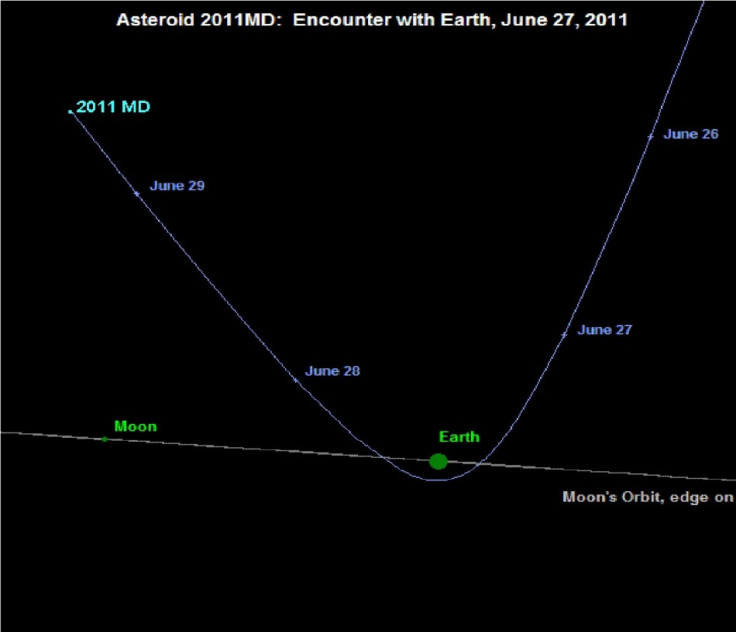2011 MD asteroid: When and from where will the giant space rock be visible on Monday?

An asteroid measuring about 16 feet to 35 feet or the size of a house, will fly by Earth at a handshaking distance on Monday and a lucky few people will be able to see the celestial wonder with their naked eye.
The asteroid, called 2011 MD, will graze past Earth's atmosphere on Monday at a distance of 7,500 miles from the Earth's surface.
According to the ranking charts of International Astronomical Union's Minor Planet Center in Massachusetts, 2011 MD will be the fifth-closest asteroid to graze past Earth. In the past, three asteroids have zoomed past Earth at a closer distance, including a tiny asteroid (2011 CQ1) which flew by on February 4 this year after coming as close as 3,400 miles away from Earth's surface. The fourth, an asteroid named 2008 TC3 had entered Earth's atmosphere on October 7, 2008, but disintegrated into tiny pieces at a height of around 23 miles off the ground.
2011 MD will be visible to the naked eye as a bright blue light as it hurtles by in a starry background.
The actual event will take place at around 1 pm EST on Monday but very few people will be able to see it.
According to Astro Bob's calculations, many people will be able to see the asteroid come close to the Earth but only a lucky few will be able to witness the actual event itself i.e. when the asteroid will be closest to the Earth's surface.
Closest approach happens around 8:30 a.m. CDT Monday over the far South Atlantic Ocean off the coast of Antarctica. Observers in Australia and New Zealand will be able to catch it in their telescopes at around magnitude 12 about a half hour before closest shave.
In the Midwest, the asteroid will be visible as a faint 14.5 magnitude speck moving at a respectable pace across the stars of Serpens low in the western sky in the early morning hours Monday, Bob King said on Astro Bob site.
Astro Bob has recommended sky-gazers to use at least an 8-inch or larger scope to spot 2011 MD.
Leading astronomy magazine Sky & Telescope also says when and from where 2011 MD will be visible best:
It takes place in broad daylight and halfway between the southern tip of South America and the northernmost point in Antarctica. The event is visible fairly low in the sky in deep twilight from South Africa.
However, the asteroid should be visible in the hours leading up to the closest approach across Australia, New Zealand, southern and eastern Asia, and the western Pacific. The farther south you are, the better. The farther west you are within this zone, the shorter the period of visibility, but the closer to Earth the asteroid will be when it disappears.
The asteroid peaks brighter than magnitude 11.0 at the places where the closest approach is visible, and it's already about magnitude 12.5 — fairly easy to spot in an 8-inch telescope — by 14:30 UT, 2½ hours before closest approach. At that point it's visible from Southeast Asia, eastern China, and Japan, as well as Australia and points between.
The asteroid will be very hard to observe after its closest approach, since it's departing more or less toward the Sun, the magazine said.
© Copyright IBTimes 2024. All rights reserved.





















